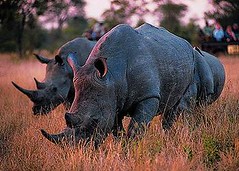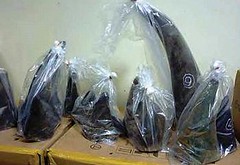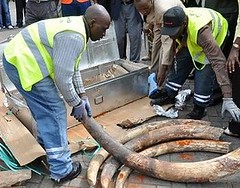 179個《華盛頓公約》(CITES)締約國談判代表12日在泰國曼谷的大會上達成決議,將擴大對瀕危犀牛的保護,立即取締他們國家中違法取得的犀牛角,並通報犀牛角出口、過境與進口的國家當局,以及公約秘書處。
179個《華盛頓公約》(CITES)締約國談判代表12日在泰國曼谷的大會上達成決議,將擴大對瀕危犀牛的保護,立即取締他們國家中違法取得的犀牛角,並通報犀牛角出口、過境與進口的國家當局,以及公約秘書處。
犀牛頭上的角是牠們遭獵殺的主因,目前國際上已有相關的貿易禁令。而根據記錄,去年有668頭南非犀牛遭到盜獵者獵殺,而到現在為止2013年已有將近150頭被殺。
各國政府同意的事項包括:立法或運用現有法規,以加強野生動物犯罪的臥底調查、並允許在調查過程受監管的情況下適度交易貨品;並立法防制洗錢、賦予政府充公違禁貨品的權力。另外,各國代表也同意起訴涉嫌盜獵犀牛的犯罪集團份子,並處以足夠達到威嚇效果的高額罰金。
 越南是犀牛角需求量最大的國家,越南人認為犀牛角可以治療癌症和宿醉,政府必須要執行相關禁制措施來減少國內需求量,並確實起訴那些犀牛角販子,讓他們得到懲罰。犀牛角是由角質素組成,和頭髮以及指甲的組成元素相同,未有證據證明攝取這種物質能有任何療效。
越南是犀牛角需求量最大的國家,越南人認為犀牛角可以治療癌症和宿醉,政府必須要執行相關禁制措施來減少國內需求量,並確實起訴那些犀牛角販子,讓他們得到懲罰。犀牛角是由角質素組成,和頭髮以及指甲的組成元素相同,未有證據證明攝取這種物質能有任何療效。
華盛頓公約簽署國政府要求越南,在參與「2012~2017年南非─越南聯合行動計畫」上,就具體的實施內容與方案要有所進展,包括:加強管理犀牛角製獎杯的進口、強化調查、起訴國內涉嫌非法交易犀牛角人士。
而莫三比克做為犀牛角交易的主要過境國家,則必須要加強立法與執法來避免犀牛角離開非洲大陸。目前,走私犀牛角在莫三比克屬於輕罪。
南非庫魯格國家公園緊鄰莫三比克,全世界大部分的犀牛都住在那裏,但公園裡也是犀牛被非法獵殺的主要地區,今年到目前為止,在南非已有146頭犀牛被獵殺。
在2011年初,在非洲白犀牛(Ceratotherium simum)有20165頭、黑犀牛(Diceros bicornis)有4880頭,但是在2006年到2012年9月間,有至少1997頭犀牛遭到盜獵,而且從2009年以來有4000逾隻犀牛角從非洲非法出口,根據估計,其中92%的犀牛是人們為了獲取犀牛角而殺害的。
《華盛頓公約》簽署國政府要求,若有足夠的經費,請秘書處召集犀牛執法特別小組,建立相關策略來增進國際間的合作。
 至於非洲象,雖然牠們面臨許多前所未有、嚴重且持續的威脅,包括非法象牙交易、人類與象群的衝突和棲地消失等,但大象在公約大會中獲得的待遇可就沒有這麼好了。
至於非洲象,雖然牠們面臨許多前所未有、嚴重且持續的威脅,包括非法象牙交易、人類與象群的衝突和棲地消失等,但大象在公約大會中獲得的待遇可就沒有這麼好了。
針對喀麥隆、剛果共和國、剛果民主共和國、埃及、衣索比亞、加彭、莫三比克、奈及利亞和烏干達等長期取締象牙走私不力的9個非洲國家,大會並未同意立即對其採取的貿易制裁。
會中通過的方案是,要求這9個國家提出明確的行動方案和期程,以保證在2014年夏季之前,控制象牙走私上有所進展;若情況未改善,屆時再考慮祭出貿易制裁手段。
不過,各國政府同意採取其他相關策略來遏止非法象牙交易,他們同意設立象牙執法小組,讓各國的執法單位之間合作的更順利。他們也會發展更精確的DNA鑑定技術,來辨別這些被沒收的象牙的出處。
各國政府同意美國的提案,針對這些影響國家安全的非法獵象行為,要求CITES的總秘書處和聯合國的毒品和犯罪問題辦事處合作。
Governments today extended greater protection to endangered rhinoceroses that are being slaughtered for their horns, which already are subject to an international trade ban. A record 668 South African rhinos were killed by poachers last year, and nearly 150 have died in 2013.
At the ongoing meeting of the Convention on International trade in Endangered Species, CITES, the 179 member governments agreed to immediately bring every seizure of illegal rhinoceros horn made within their territories to the attention of authorities in countries of origin, transit and destination and to the attention of the CITES Secretariat.
In addition, governments agreed to enact legislation or use existing legislation to facilitate the use of covert investigations and controlled deliveries in the investigation of wildlife crime and enact anti-money laundering and asset forfeiture legislation.
The delegates also agreed to prosecute members of organized crime groups implicated in rhinoceros-related crimes and apply penalties strong enough to act as effective deterrents.
Vietnam, where rhino horn demand, stoked by claims that the horn cures cancer and hangovers, is strongest, must implement a strategy to reduce demand in the country and ensure rhino horn traffickers are prosecuted and punished. Rhino horns are composed of keratin, the same material that hair and nails are made of, and no curative properties have ever been proved for the ingestion of this substance.
The CITES member governments directed Vietnam to make progress with the development and implementation of the South Africa – Vietnam 2012 to 2017 Joint Action Plan by strengthening management of imported rhino horn trophies, and to improve investigations and prosecutions of Vietnamese nationals suspected of illegally trading in rhino horn.
Mozambique, a major transit country for rhino horn, must strengthen legislation and enforcement to reduce horns leaving the African continent. Currently, it is just a misdemeanor to smuggle rhino horns through Mozambique.
Mozambique shares a border with South Africa's Kruger National Park, where most of the world's rhinos live. The park is also the epicenter of illegal rhino killing. This year, 146 rhinos have been poached in South Africa.
By the beginning of 2011 there were 20,165 White Rhinoceros, Ceratotherium simum, and 4,880 Black Rhinoceros, Diceros bicornis, in Africa. But at least 1,997 rhinos were poached between 2006 and September 2012 and over 4,000 rhino horns have been illegally exported from Africa since 2009, with an estimated 92 percent of these coming from rhinos specifically killed to obtain their horn.
If funding is available, the CITES member governments asked the Secretariat to convene a Rhinoceros Enforcement Task Force to develop strategies that improve international cooperation.
Elephants did not fare so well at the CITES meeting although African elephants face numerous, serious and on-going threats on an unprecedented scale including illegal ivory trade, human-elephant conflict and habitat loss.
Still, governments today decided against immediate trade sanctions against nine African countries that have repeatedly failed to tackle the illegal trade in ivory: Cameroon, Republic of Congo, Democratic Republic of the Congo, Egypt, Ethiopia, Gabon, Mozambique, Nigeria and Uganda.
Instead those countries must identify actions and deadlines to ensure progress in controlling illegal ivory trade before summer 2014, with the potential threat that they could face trade sanctions then if there is no improvement in the situation.
Governments adopted other measures to help curb the illegal ivory trade. They agreed to create an Ivory Enforcement Task Force, which will allow for better law enforcement collaboration between countries. And they will implement better DNA-based forensic techniques to identify the origin of confiscated ivory.
Governments agreed to a U.S. proposal requesting the CITES Secretary-General to cooperate with the UN Office on Drugs and Crime on national security implications of the illegal killing of elephants.
※ 全文及圖片詳見:ENS




